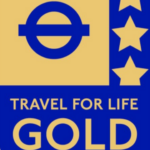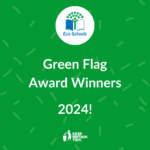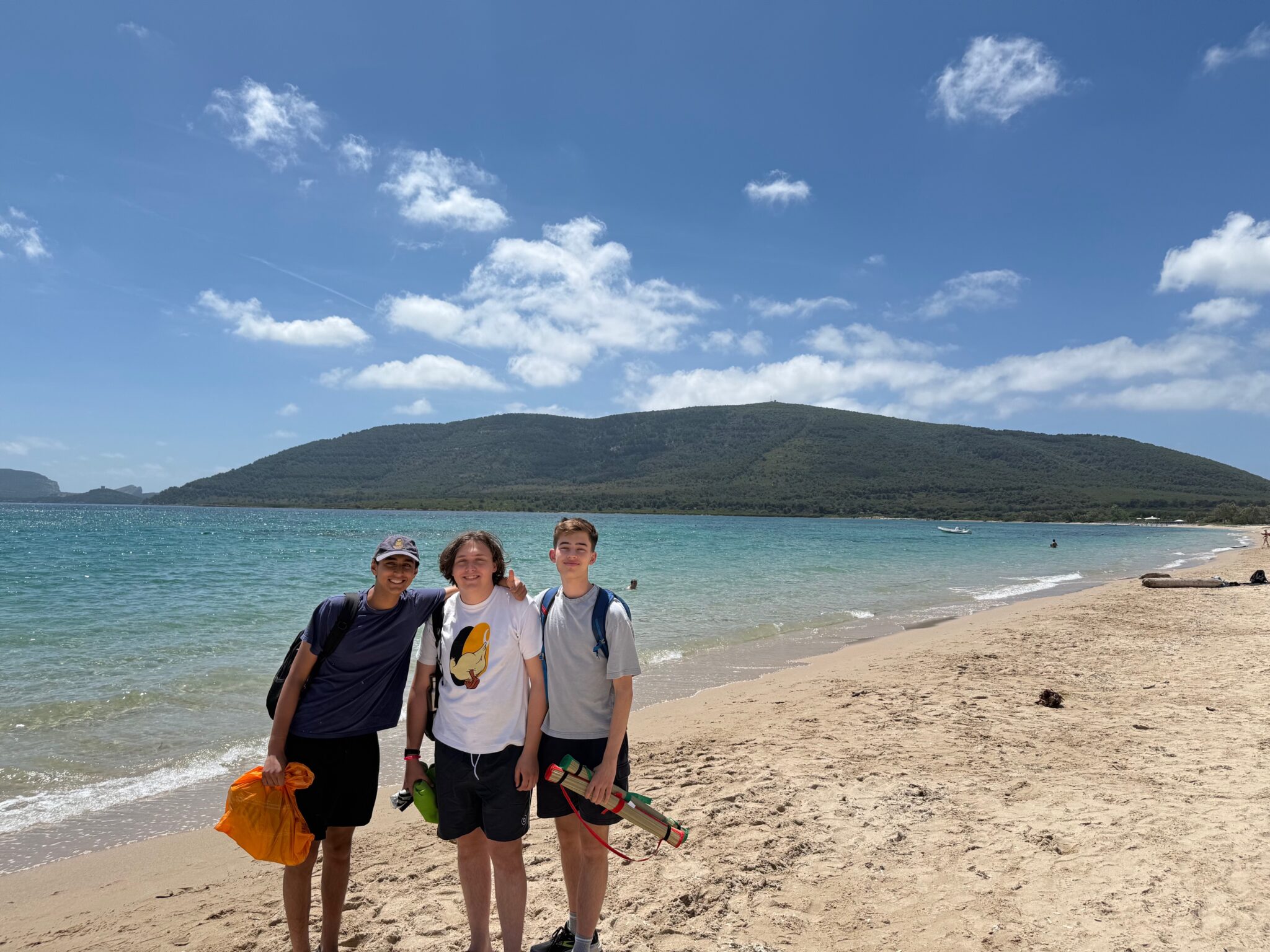
25 Year 12 Classics/Latin students enjoyed an intrepid adventure to Sardinia, exploring its Bronze Age civilisation and visiting its dazzling white beaches, alternate with creeks and mysterious grottoes. We had various encounters with the fairies of the ‘domus de janas’ chamber tombs and the pink flamingoes inhabiting Lake Molentargius.
A highlight was a boat tour to Neptune’s Grotto and around the Sardinian coastline, as well as spending well-earned time in the ‘natatio’ (swimming pool), modelled on a traditional Roman bathing experience. Pizza, pasta and mocktails were lapped up in good measure, as we covered the length and breadth of the island with its vast array of flora and fauna.
Day 1 – Alghero
The trip began bright and early at Gatwick before the group descended on sunny Sardinia. Our first stop was to Nuraghe La Prisgonia, an apt start given the ubiquitous, conical stone towers (‘nuraghi’) dotted about the island, which prompted excellent discussion of their religious, military and/or administrative purposes. We were able to enter the nuraghe and students admired its beehive structure and ‘worker bee’-style compartmentalisation of the site.
We then visited the Tomba dei Giganti (Tomb of the Giants), a prehistoric tomb with a monumental façade, surrounded by myrtle trees and rolling rural landscapes.
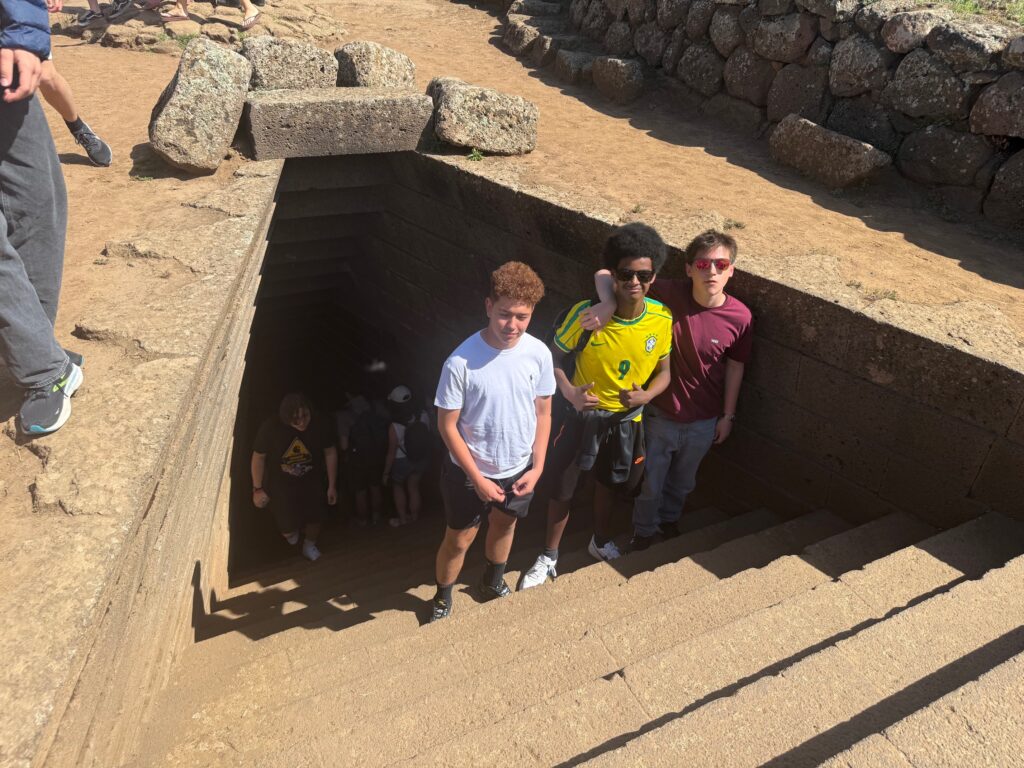
Before checking in to our excellent hotel, complete with rooftop bar and underground swimming pool, we enjoyed a walking tour around the cobbled streets of the old town (‘Alghero Vecchia’), with pit-stops at the Cathedral of Santa Maria and the defensive tower with ‘ballista’ protecting the seafront. There were various red coral displays given the content of the local museum, which prompted an enlightening discussion of Perseus’ use of Medusa’s head to create red coral in Ovid’s ‘Metamorphoses’.
We enjoyed a lovely meal of local Sardinian pasta at our hotel, before bedding down for the night, with balconies which looked out onto the sun setting over the coast of Alghero.
Day 2 – aqua
The second day began with a boat tour around the Sardinian coast – this was a terrific adventure with beautiful views of the rugged coastline with all its grottoes, rocky coves and hidden bays. We ventured towards Neptune’s Grotto, but alas, the god of the sea had roughened the waters and so the boat could not be moored appropriately. Like Odysseus at the land of the Laestrygonians, we made a swift escape from potential danger, before arriving back at Alghero to enjoy a lovely lunch along the coast. There were so many excellent shops and restaurants, and students stocked up on various precious Sardinian stones, souvenirs and the obligatory bubble tea.
Next was a visit to the beautiful beach Platja del Llatzeret where students enjoyed paddle-boarding out to sea, sun-bathing and volleyball. This was a gorgeous beach and not particularly busy – one of the highlights of the tour!
We went back to the hotel for some drinks on the rooftop bar, and a dip in the Roman swimming pool (‘natatio’), complete with jacuzzi and Turkish steam room.
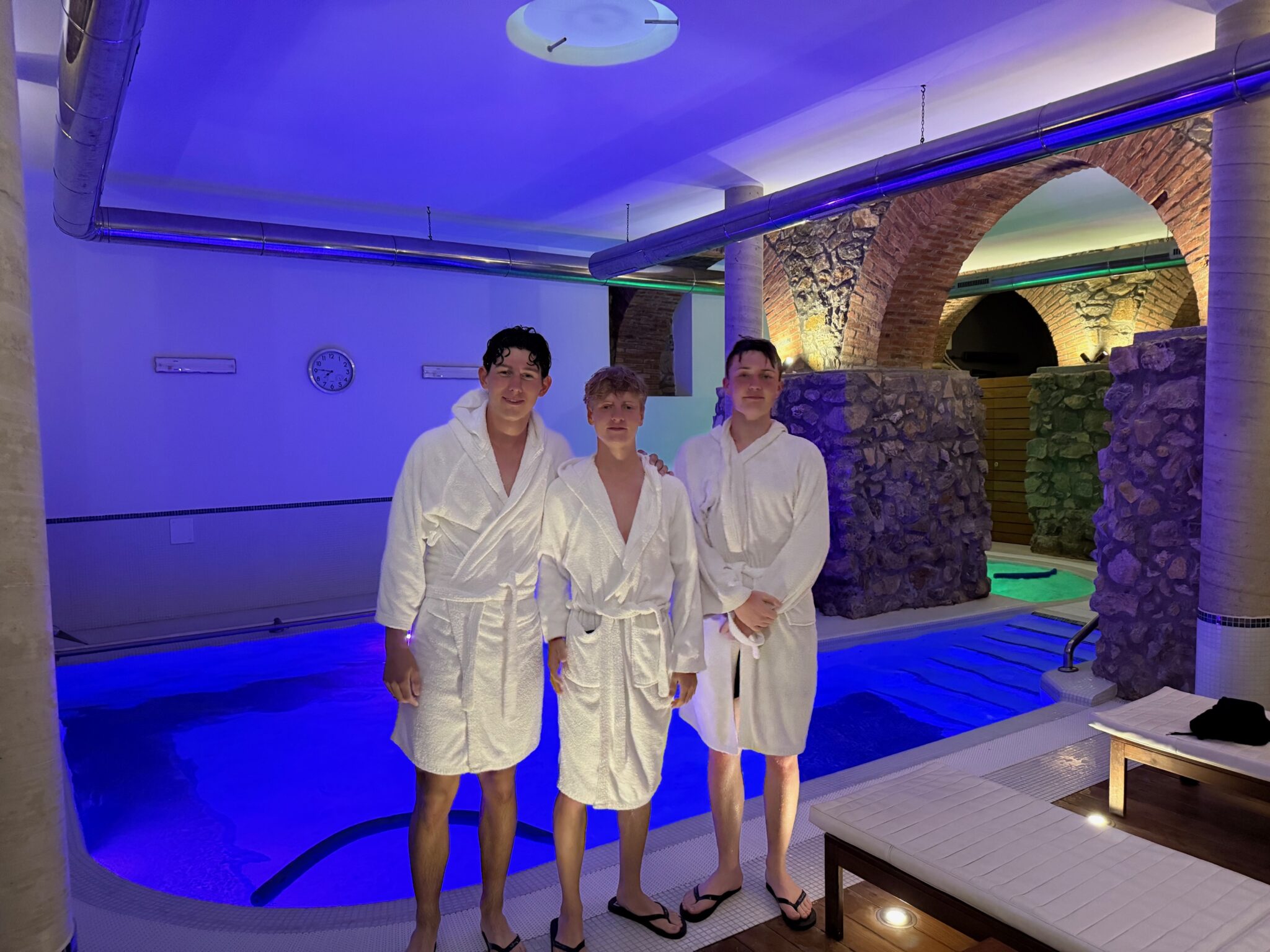
Kit commented, “The Sardinia trip was a wonderful balance between visiting amazing ancient sites and learning fascinating facts about the country and its ancient cultures. We had lots of fun exploring the different places we visited. My favourite part of the trip was hiking up a lovely trail to visit the tombs as well as seeing a stunning view of Sardinia!”
Day 3 – terra
Day Three was a jam-packed day with various stops along the serpentine rural areas of Sardinia. First was a visit to the Santa Cristina Sacred Well, possibly linked to the water cults, and the site of astronomical observation to measure the celestial motions. An amateur astrologer was there making calculations when we arrived, a suitably classical cameo which reminded us of the bearded ‘astrologus’ of Cambridge Latin Course, Book 2. Students were fascinated by the age and design of the site, and asked lots of interesting questions about the function of the mysterious well.
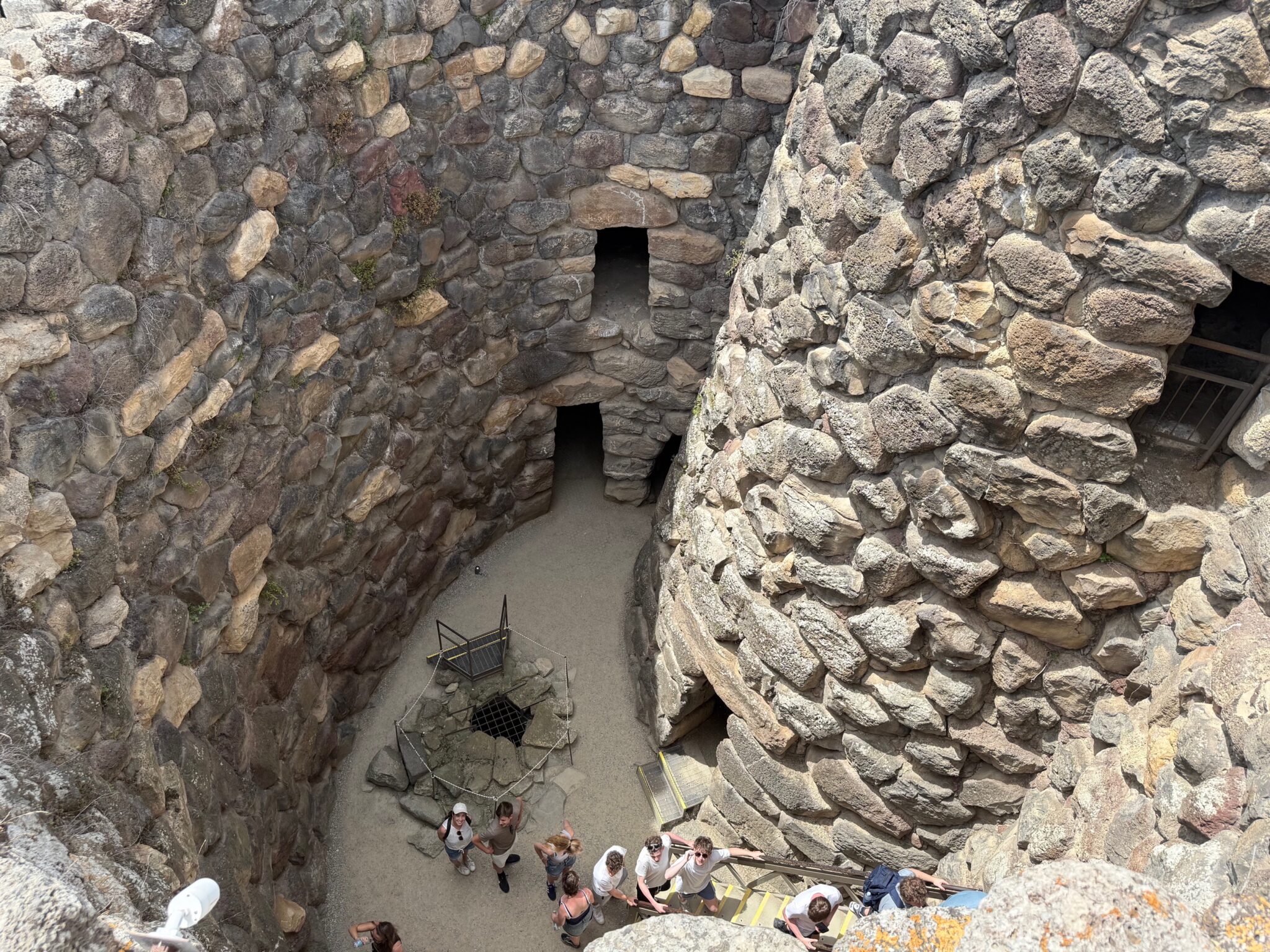
Next was a trip to the Giant’s tomb: Sa Domu ’e S’Orcu, a Bronze Age tomb constructed from vast basalt blocks, located in spectacular countryside amongst the mountains, and next door to traditional shepherds’ huts.
This was followed by a visit to Sardinia’s only UNESCO World Heritage Site, Su Nuraxi di Barumini, the best example of a nuragic complex, composed of multiple military fortresses, similar to a medieval castle. What was excellent about this visit was the chance to explore each nuraghe, involving a fair bit of climbing and corporeal contortion! You could see the niches and stairwells which would have connected the different floors of each tower and the central ‘tholos’. It was a tangible site which invited great discussion of the various cultures influencing and vying for control over Sardinia.
We then stopped off at windswept Monte Sirai with its funerary monuments and evidence of Tophet (child burial), with low-ceilinged tombs which were very atmospheric, packed with sarcophagi (stone coffins) and etched with cultic carvings, including an inverted symbol of the Punic goddess Tanit. This was an eerily claustrophobic place, variously compared by students and staff to the ‘The Blair Witch Project’ and the final scene of Verdi’s ‘Aida’.
We then arrived at our hotel in Sant’Antioco, ‘the island within the island’ and the fourth largest within Italy, surrounded by reed-fringed wetlands, crystalline waters and families of nesting flamingos.
Dinner was a lovely pizza at a local trattoria before we bedded down in our second hotel, right by the seafront of Sant’Antioco.
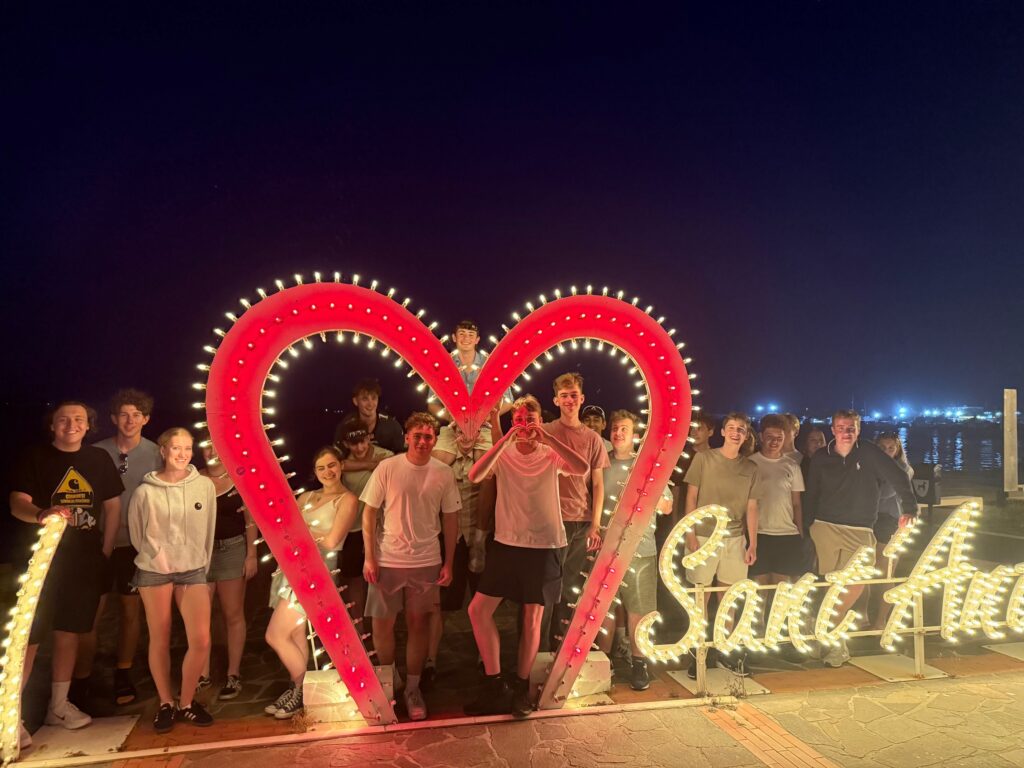
Day 4 – Sant’Antioco
Day Four involved a hike up Montessu Necropolis, complete with its 40 rock-cut tombs or ‘domus de janas’ (house of the fairies). Once more, there were various thousand-year old carvings and the chance to enter various chambers, one of which contained a skeletal hollowed-out eyes and nose. A Sibylline guide accompanied us around the ‘domus de janas’, but then vanished, adding to the mysterious aura of the site. We looked out for the various fairies who are said to frequent the mountains – unfortunately, Mr Morrison was unable to summon them on this occasion.
Next was a guided tour of the Sant’Antioco Archaeological Museum, followed by a visit to the Tophet and hypogeum, a warren of Punic chamber tombs which were converted into housing and used until the 1960s.
Dinner was another excellent pizza – a ‘Seneca pizza’ of capers, anchovies and olives – followed by time for some souvenir shopping and a game of football with the athletic Mr Flintoff.
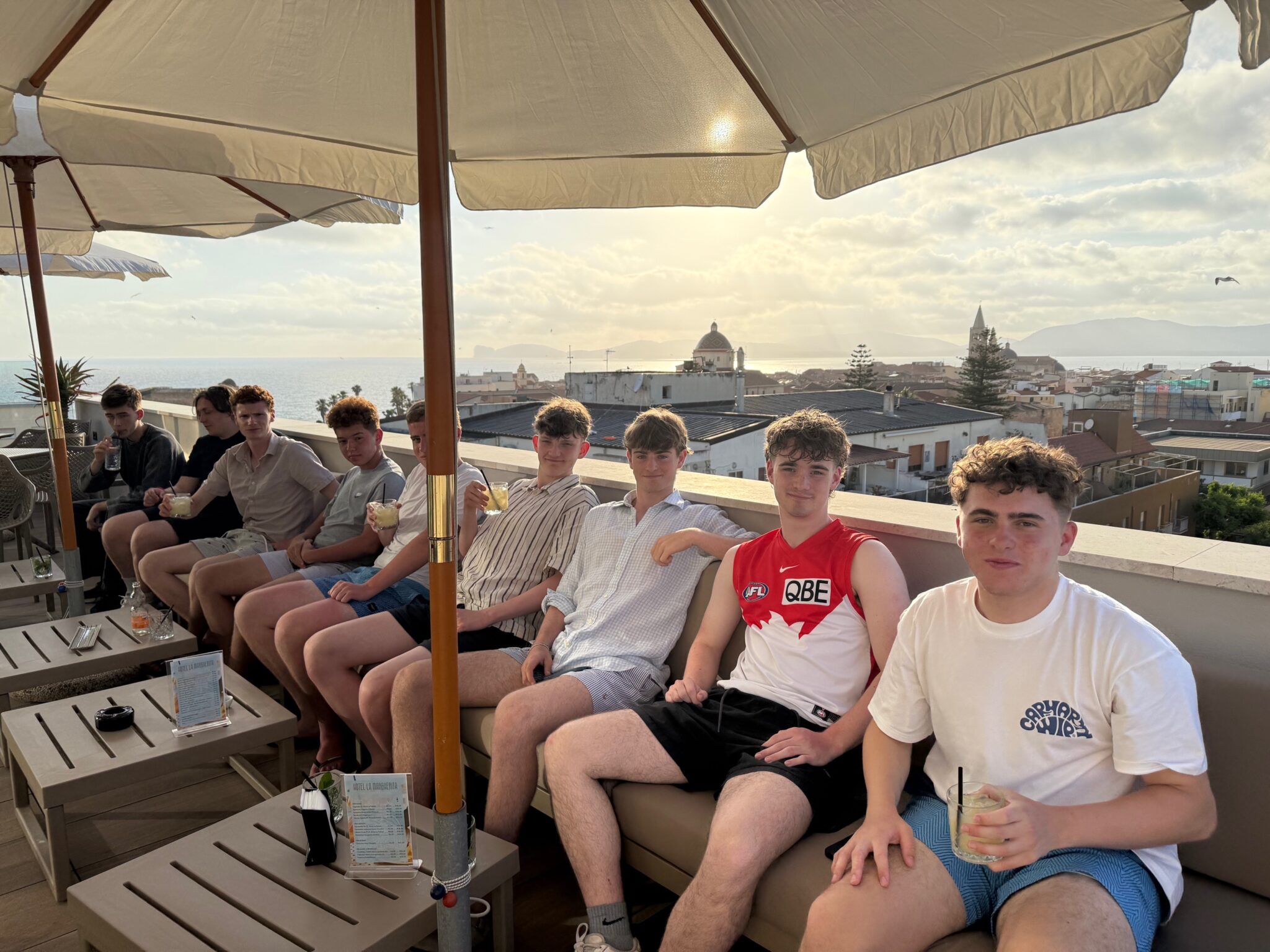
Day 5 – Cagliari
Our final day was a journey to Cagliari, via the Atilia Pomptilla Tomb (sometimes called ‘The Vipers’ Cave’ owing to its decoration). Our courier read a copy of one of the original poems inscribed inside, and Ms Ferstman discussed its mythological connotations as well as its links to the GCSE Latin set texts.
We then visited the Cagliari Botanical Gardens, home to around 2,000 plant species, including ancient Roman cisterns and natural caves. Lots of these plants are endemic to Sardinia, and were nestled amongst gorgeous fountains and tropical plants.
We stopped at the Cagliari Amphitheatre, carved into the rocks, and once home to the carnage of gladiator fights and public execution, before visiting the Museum, which contained the famous Giants of Mont’e Prama, the oldest ever statues found in the Mediterranean, as well as the Nora Stone which bears the first recorded reference to ‘Sardinia’. We also enjoyed translating the Latin on a Roman military ‘diploma’ and spotting busts of the various emperors.
Our final stop was at Poetto Beach, an 8km stretch of gorgeous white sand and crystalline sea. There were various cafés along the seafront where we tucked into a final meal, before departing for the airport via Lake Molentargius, a massive saltwater basin home to a group of pink flamingos. We bid them a fond farewell before jetting off into the night back to Blighty.
Joseph concludes, “The Sardinia trip is unequivocally a highlight of my time at Emanuel. A swathe of archaeological sites across the captivating island combined with a great group of people made for a scintillating school trip. I won’t even mention the breathtaking beaches!”
Students were impeccably behaved on what for many was their last overseas excursion at Emanuel. It was the trip of a lifetime, and thank you to Ms Ferstman and Mr Flintoff for all their support and guidance along the way.
Hail and farewell,
-Mr Morrison, Teacher of Classics










